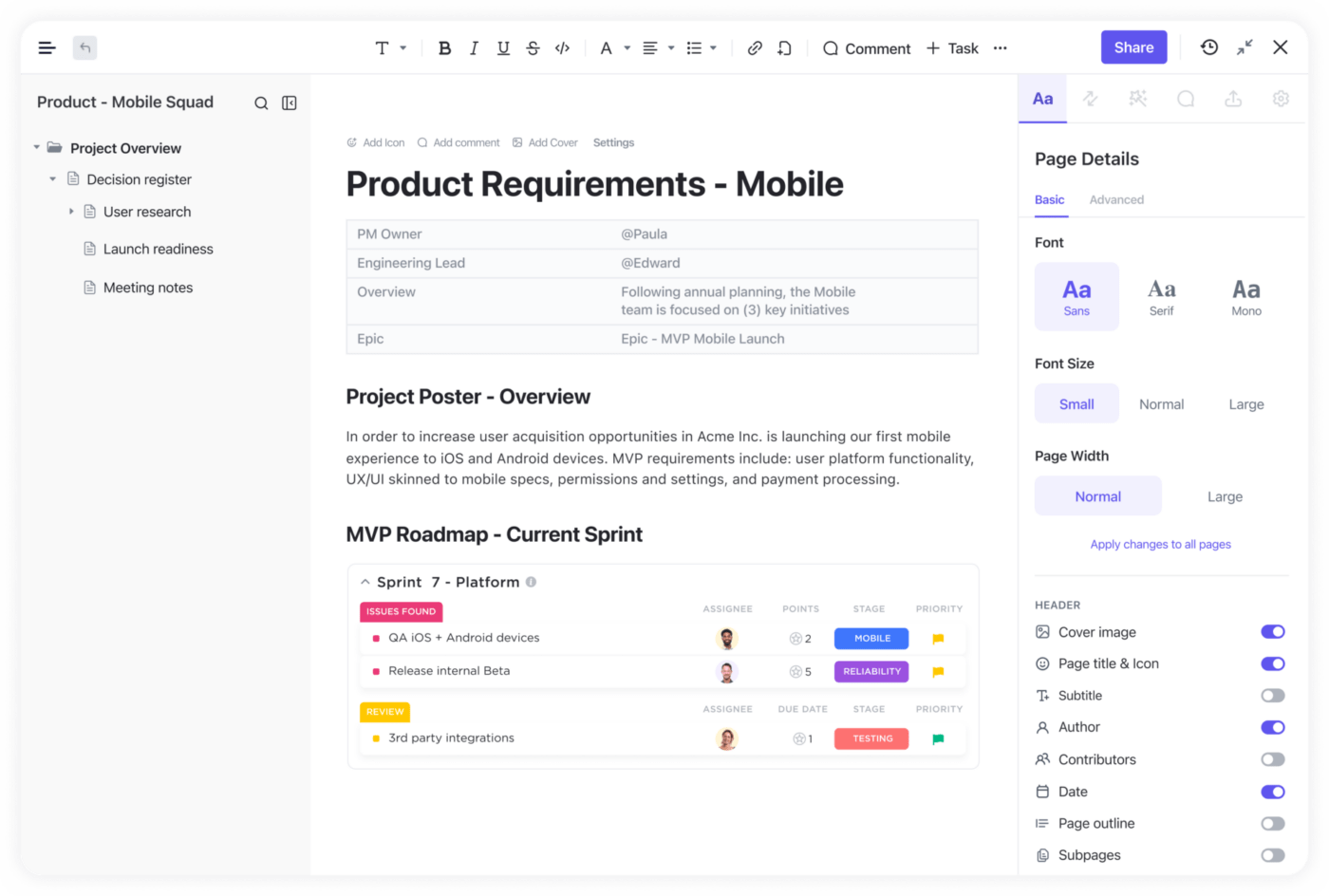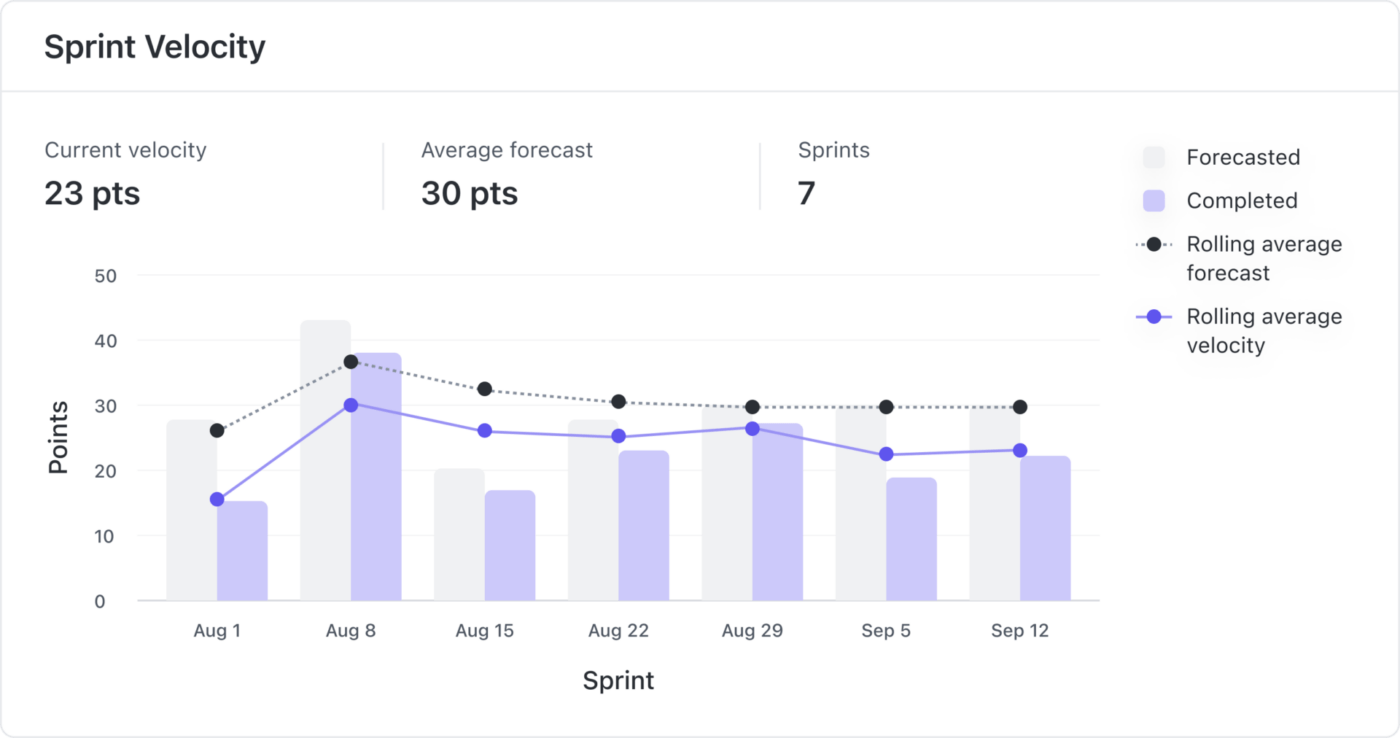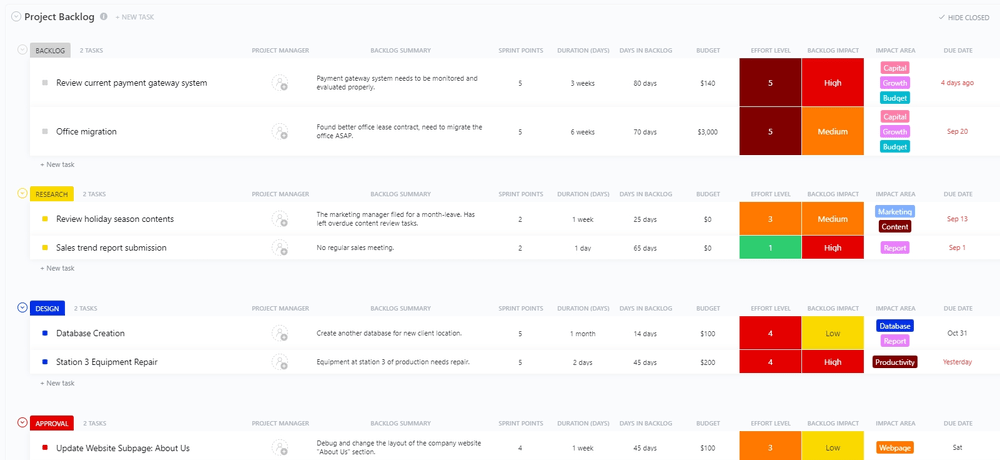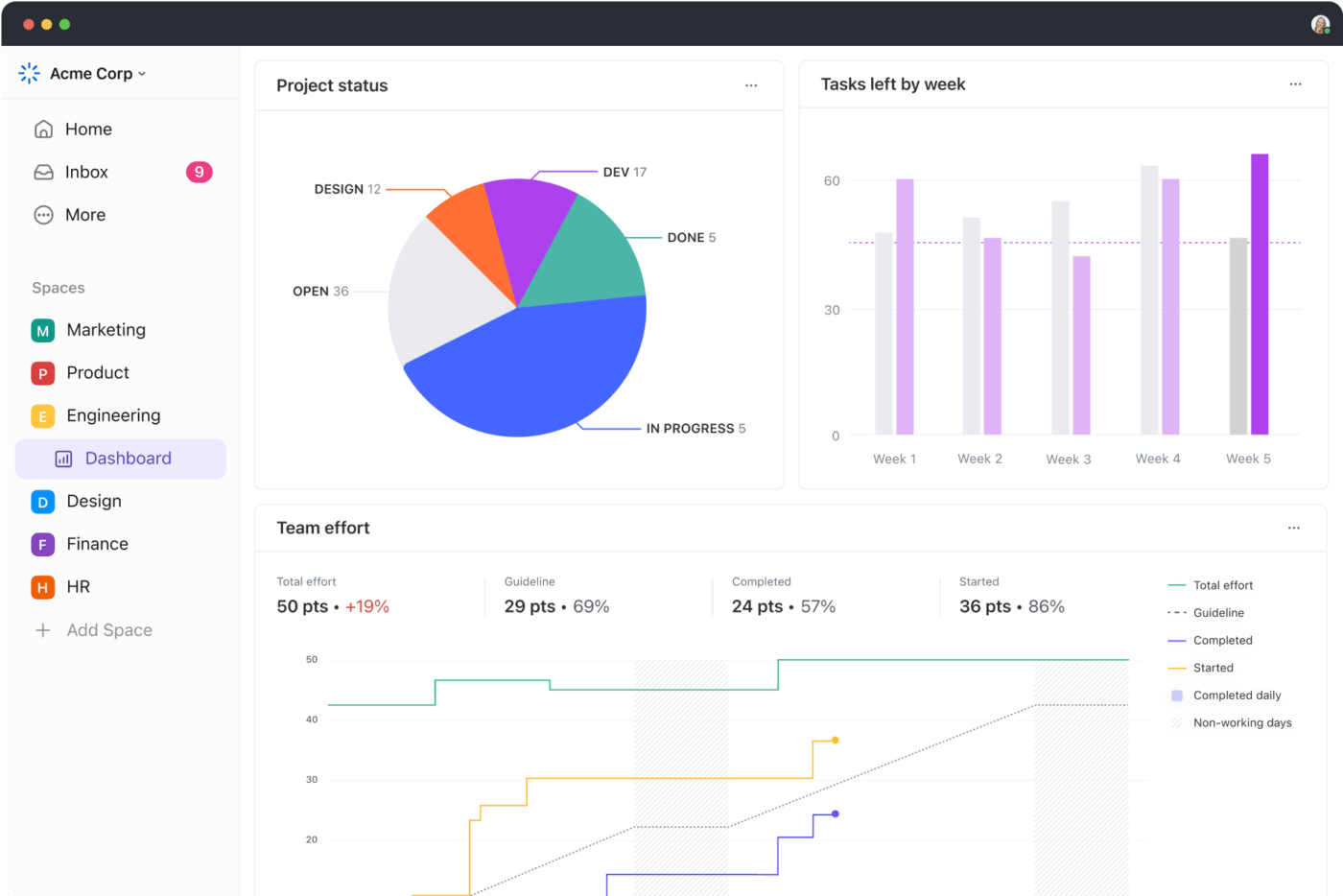إذا كنت جديدًا في مجال التطوير الرشيق، فإن معرفة سرعة العدو السريع ومخططات السرعة يمكن أن تكون محنة مربكة. حسنًا، الأمر كله يتعلق بالحفاظ على النتيجة!
سرعة العدو مثل النقاط في لعبة كرة السلة عالية المخاطر. إنها تساعد أجايل و فريق سكروم يعرف الأعضاء ما إذا كانوا يفوزون أو يخسرون مع مرور الوقت.
من خلال فهم وتوظيف سرعة السبرنت، يمكن لفرق التطوير تحسين إيقاع عملهم وتبسيط التطوير الرشيق العمليات. الفكرة العامة هي أنه كلما زادت السرعة، كلما زادت السرعة كلما قطعت مسافة أكبر في كل سباق سريع وكلما اقتربت من الفوز باللعبة في ظل قيود مثل الوقت والميزانية.
اعتبر هذا الدليل بمثابة فيل جاكسون لحساب سرعة العدو السريع لفريقك وتحسينها. كما سنقدم أيضًا رؤى واستراتيجيات لتعزيز إنتاجية الفريق خلال دورات العدو السريع لمساعدتك على تحقيق النصر.
_هل أنت جاهز للسيطرة على الملعب الرشيق؟ 🏀
ما هي سرعة السبرينت؟
تعمل فرق أجايل في مراحل تطويرية قصيرة تُعرف باسم دورات العدو السريع. كل دورة، تمتد عادةً من أسبوع إلى أربعة أسابيع، تقسم المشروع إلى مكونات قابلة للقياس من العمل اللازم لشحن البرنامج.
من المؤكد أن زملائك في الفريق يخططون ويبرمجون ويعالجون تراكمات المنتج ويعيدون العمل على الميزات في كل سبرنت، ولكن كيف يمكنك تقدير الوقت الأمثل المطلوب للتسليم؟ هذا هو بالضبط سبب حساب السرعة. ⚡
تتتبع سرعة البصمة بفعالية تقدم فريقك وتقدر مقدار العمل الذي يمكنهم إنجازه في دورة العدو السريع. سيكون لكل دورة سرعة معينة فيما يتعلق بما أنجزه الفريق. سيساعدك متوسط السرعة على مدار الدورات الثلاث إلى العشر الأخيرة على التنبؤ بالكمية القياسية للعمل الذي ينجزه منتجك أو فريق التطوير في كل دورة سريعة.
ما هو الغرض من تقدير سرعة العدو السريع؟
سرعة العدو السريع ليست مقياسًا للنجاح، ولكنها تقدير لفهم قدرة الفريق . يمكن أن يكون مقياسًا اعتباطيًا إلى حد ما قد يتغير بناءً على عوامل مثل تعقيد المشروع أو تكوين الفريق أو التأثيرات الخارجية.
لكنك ما زلت بحاجة إلى قياس سرعة العدو السريع من أجل:
- تقييم متى يمكن لفريقك إكمال مشروع معين
- ضبط نطاق سباقات السرعة المستقبلية وتصميم عبء العمل بناءً على معدلات التقدم الحالية
- مراجعة وإدارة توقعات أصحاب المصلحة بدقة أكبر
تشير سرعة العدو السريع أيضًا إلى التحسن المستمر في الفريق فيما يتعلق بالإنتاجية. في معظم الحالات، تتجه تقديرات السرعة إلى الأعلى بشكل مطرد، مما يشير إلى أن الفريق أصبح أكثر كفاءة بمرور الوقت.
نصيحة احترافية: تتعلق سرعة فريقك بمدى موثوقية تحقيق أهداف العدو السريع. إذا كنت ترغب في تحسين كفاءة سير العمل لديك، فاستخدم قالب ClickUp Sprints . يأتي مع الإعداد المسبق مقاييس رشيقة والحقول المخصصة لمساعدتك في حساب سرعة الفريق على أي نطاق. والجزء الأفضل؟ إنه مجاني تمامًا!

استفد من هذا القالب لتحسين سير العمل في سباقات السرعة من خلال إمكانات تتبع الوقت والعلامات وتحذيرات التبعية وتكامل البريد الإلكتروني والمزيد
/ctaBtn/الأخضر https://app.clickup.com/signup?template=t-38266606 قم بتنزيل هذا القالب /%ctaBtntn/
كيفية حساب سرعة العدو السريع: المعادلة والخطوات
حساب سرعة العدو في تطوير البرمجيات بسيط بمجرد فهمك للمعادلة الأساسية وهي
سرعة البصمة = إجمالي العمل المنجز في x عدد سباقات السرعة السابقة ➗ عدد سباقات السرعة السابقة، أي x
لاستخدام هذه الصيغة، على الرغم من ذلك، تحتاج أولاً إلى معرفة مجموعة متنوعة من الأشياء، مثل مقياس حساب العمل المنجز والعمل المتراكم في سباقات السرعة. دعنا نقسم لك العملية من خلال ثلاث خطوات قياسية متبوعة بأمثلة:
الخطوة 1: تحديد مقياس لتتبع التقدم المحرز على مدى عدة سباقات سريعة
يتطلب حساب السرعة قياس سرعة العمل عبر أبعاد متغيرة مثل الفريق والمشروع والعميل، وهو ما قد يكون صعباً. لهذا السبب تحتاج إلى تحديد مقياس مناسب لتقدير العمل المنجز بدقة. المقاييس الثلاثة الشائعة المستخدمة هي
- نقاط القصة: تصف قصة المستخدم بإيجاز الميزات المطلوبة من وجهة نظر العميل. يستغرق إكمال كل قصة مقدارًا معينًا من الوقت والجهد بناءً على مدى تعقيد العمل المتضمن، والذي يتم تحديده من خلال نقاط القصة. للعثور على مقدار العمل المنجز في دورة السباق، عليك التفكير من حيث - كم عدد نقاط القصة التي تم إنجازها في دورة السباق، لنفترض أن فريقك أنهى قصص المستخدمين التي تبلغ قيمتها 26 نقطة في دورة السبرينت 1، وبالتالي فإن العمل المنجز في هذه الدورة هو 26. يمكنك قراءة هذا الدليل السريع لـحساب نقاط القصة في أجايل
- الساعات: إذا كنت تفضل مقياسًا أكثر تقليدية، يمكنك حساب سرعة العدو بالساعات من خلال إيجاد عدد الساعات التي تم إنفاقها على قصص المستخدمين المكتملة في كل سباق سريع - لنقل 120 ساعة. قد تقدم هذه الطريقة قيمة أقل دقة للعمل المنجز مقارنة بنقاط القصة، خاصة إذا كانت تقديرات الوقت غير متوقعة
- الأيام المثالية: قد تقوم العديد من الفرق بحساب سرعة العدو السريع في الأيام المثالية، حيث يشير كل يوم مثالي إلى عدد ساعات العمل في يوم عمل عادي (لنقل 8 ساعات). على سبيل المثال، يمكن التعبير عن ال 120 ساعة من العمل المنجز في سبرينت 1 على أنها 120/8 أو 15 يومًا مثاليًا
تجد معظم الفرق أن الحسابات المستندة إلى النقاط القصصية أكثر ملاءمة لتتبع تقدم الفريق لأنها تأخذ في الاعتبار مستويات التعقيد المتفاوتة لمهام التطوير المختلفة، وغالبًا ما تستخدم التسلسل القائم على فيبوناتشي .
يمكنك اختيار مقياس أثناء التخطيط للسباق السريع، ويفضل أن يكون ذلك قبل السباق الأول. أيًا كان المقياس الذي تختاره سيحدد أيضًا كيفية تعبير فريقك عن السرعة - سواء من خلال نقاط القصة أو الساعات أو الأيام المثالية.
الخطوة 2: احسب العمل المنجز لكل سباق سريع قيد الدراسة
استخدم المقياس المفضل لديك لتحديد العمل الذي أداره فريقك لسلسلة من سباقات السرعة. يمكن أن يشمل العمل ما يلي تصفية العناصر المتراكمة وإصلاح مواطن الخلل، والعمل على الميزات الجديدة التي يقترحها مالك المنتج.
من الناحية المثالية، يجب أن تفكر في العمل المنجز في ثلاثة سباقات سريعة لإنشاء سرعة قياسية للفريق. ومع ذلك، إذا كان العمل المنجز متذبذبًا بشدة، فقد تحتاج إلى المزيد من سباقات السرعة لتثبيت معدل التقدم.
الخطوة 3: ابحث عن متوسط سرعة العدو السريع لفريقك
بمجرد حصولك على الأرقام الخاصة بك للعمل المنجز خلال سباقات السرعة المحددة، ما عليك سوى إيجاد المتوسط. اجمع مجموع نقاط القصة الإجمالية أو الساعات أو الأيام المثالية واقسم الناتج على عدد سباقات السرعة المنجزة.
دعنا نستعرض بعض الأمثلة العملية لمزيد من الوضوح.
مثال #1 حساب سرعة العدو السريع باستخدام نقاط القصة
لنفترض أننا نحتفظ بسجل لنقاط القصص المكتملة في سباقات السرعة الثلاثة السابقة:
السبرينت 1: أكمل الفريق 10 قصص مستخدمين بقيمة 3 نقاط لكل منها وقصة مستخدم معقدة أخرى بقيمة 6 نقاط. هذا يعني 36 نقطة قصة إجمالاً (باستثناء القصص المكتملة جزئياً)
البصمة 2: تمكنا من إدارة 9 قصص مستخدمين تبلغ قيمة كل منها 5 نقاط، أي 45 نقطة قصة
البصمة 3: 38 نقطة من القصص المنجزة بقيمة 38 نقطة من القصص
الآن اجمع نقاط القصة وطبق المعادلة: (36+45+38 نقطة قصة) /3 سباقات السرعة، والنتيجة هي 39.67.
في هذه الحالة، متوسط سرعة البصمة هو 39.67 نقطة قصة في كل سباق، وهذا هو في الأساس مقدار الجهد الذي يمكن لفريقك أن يبذله في كل سباق.
مثال رقم 2 حساب سرعة العدو السريع باستخدام الساعات
يتبع حساب سرعة العدو السريع باستخدام الساعات كمقياس نهجًا مشابهًا للمثال السابق، ولكن هنا يتم ترجمة المهام إلى ساعات.
الطبعة 1: 160 ساعة لإنجاز 5 مهام
البصمة 2: 240 ساعة لإنجاز 8 مهام
البصمة 3: 180 ساعة لإنجاز 6 مهام
عبر سباقات السرعة الثلاثة الماضية، استثمر الفريق ما مجموعه 580 ساعة. أي ما يعادل 193.33 ساعة تقريبًا لكل سبرنت، مما يجعل متوسط سرعة العدو السريع 190 ساعة.
يساعد استخدام تقديرات الساعات على فهم عدد الساعات التي يمكن للفريق تخصيصها بشكل واقعي لعمل المشروع دون الإفراط في الالتزام. في مثالنا، ستلاحظ وجود أزمة جديرة بالملاحظة خلال العدو الثاني قد لا تكون واقعية وتحتاج إلى معالجة.
## مثال #3 حساب سرعة العدو السريع باستخدام الأيام المثالية
غالبًا ما يبدأ استخدام الأيام كمقياس بتحديد اليوم المثالي. قد تضطر إلى إحصاء إجمالي الناتج من عدة سباقات سريعة من قبل. في مثالنا، لنعتبر أن اليوم المثالي هو 8 ساعات.
الطبعة 1: 96 ساعة عمل. 96/8 يساوي 12 يومًا مثاليًا
البصمة 2: 120 ساعة - 15 يومًا مثاليًا
البصمة 3: 108 ساعة عمل - 13.5 يوم مثالي
بجمع الأيام المثالية لكل سباق سريع، نحصل على 40.5، وبالتالي فإن المتوسط هو 13.5 يوم مثالي لكل سباق سريع.
6 استراتيجيات لتحسين سرعة فريقك وتحقيق الاستقرار في السرعة
يجب أن تكون سرعة السبرنت مستقرة حتى تكون موثوقة أو مفيدة لتخطيط السبرنت. ومع ذلك، يمكنك أن تتوقع سرعة متقلبة للغاية بسبب مشاكل مثل:
- مشروع رشيق مفرط التعقيد
- اختبارات واجتماعات غير ضرورية
- مدخلات محدودة من مالك المنتج
- تراكم المنتج غير المنقح
- نقص الموظفين
على الرغم من أن بعض هذه المشاكل خارجة عن سيطرتك، إلا أنه يمكنك تجنب انتكاسات الإنتاجية الشائعة باستخدام حل إدارة المشاريع مثل انقر فوق . يساعدك البرنامج على إدارة المشاريع بفعالية والحفاظ على سرعة أعلى مع تقدم سير العمل.
لقد قمنا بتجميع ست استراتيجيات معتمدة من الخبراء لتحسين سرعة الفريق واستقرارها. سنقوم أيضًا بتوضيح بعض الوظائف المفيدة مع مجموعة ClickUp Agile Suite ، مثالية لتتبع سرعات العدو السريع والحفاظ على إنتاجية الفرق. 👇
1. توثيق سير عملك وتحسينه
يمكن أن تنحرف فرق العمل الرشيقة عن مسارها بسبب سوء تحسين سير العمل، مما يؤدي إلى خفض سرعتها. تخيل هذا: ميريام، مبرمجة ماهرة، تقضي 4 ساعات من يوم عملها في سؤال أعضاء الفريق عن متطلبات المنتج الدقيقة. ماذا لو حدث هذا مع الفرق الأخرى أيضًا؟ تنخفض سرعتك.
الطريقة الوحيدة لتبسيط إجراءات العمل المختلفة وتقليل الأخطاء في كل سباق سريع هي توثيق كل شيء - من المستخدم دراسات الحالة و متطلبات المشروع للعناصر المتراكمة
خذ مستندات ClickUp على سبيل المثال - يساعدك على جعل وثائق منتجك مركزية في تنسيق يسهل البحث فيه. يمكنك تفصيل المواصفات المطلوبة، ومشاركة النماذج الأولية والتعاون بشأنها، وتنظيم الأعمال المتراكمة لكل سباق سريع، كل ذلك في مكان واحد.

بمساعدة مستندات ClickUp Docs، يمكنك عرض متطلبات المنتج الخاص بك كل ذلك باستخدام طريقة عرض القائمة المضمنة
كمحطة واحدة أداة التخطيط للسباق السريع تقدم ClickUp العديد من الميزات الأخرى لتحسين سير عمل فريقك، مثل:
- ClickUp AI
: يحتوي مساعد الذكاء الاصطناعي الخاص بالمنصة على مكتبة واسعة من المطالبات الخاصة بالصناعة المصممة لتلبية أدوارك الفريدة. يمكن لزملائك في الفريق استخدام الأداة كشريك في الكتابة والعصف الذهني، والاستفادة منها في مهام مثل:
- كتابة دراسات الحالة وخطط الاختبار ووثائق المشاريع التقنية
- تلخيص ملاحظات الاجتماعات والبيانات الأخرى
- العصف الذهني لأسماء الميزات
- أتمتة النقر فوق الأتمتة : استخدم الأتمتة السلسة لتسريع المهام الروتينية التي تستغرق وقتاً طويلاً. يمكن لزملائك في الفريق الاختيار من بين أكثر من 100 عملية أتمتة مبنية مسبقًا أو إنشاء عمليات أتمتة خاصة بهم، مما يسمح لهم بتسريع سير العمل وتعزيز القدرة على مهام التطوير المهمة
- اكتشاف التعاون : تسمح هذه الميزة لزملائك في الفريق بمعرفة متى يعمل زميل آخر على نفس المهمة أو المستند الذي يعمل عليه، مما يمنع حالات ازدواجية الجهد

عرض الأتمتة النشطة وغير النشطة وإدارتها بسرعة عبر المساحات مع تحديثات المستخدم وأوصافها
2. تصور التقدم المحرز من خلال تقارير السرعة
ليس عليك الانتظار حتى انتهاء ثلاثة سباقات سريعة للحصول على فكرة عن سرعتك. تستخدم العديد من الفرق الآن تقارير مرئية لمراقبة تقديرات سرعة العدو في الوقت الفعلي.
هناك طريقتان شائعتان لتتبع السرعة هما:
- مخطط سرعة البصمة: هو تمثيل بياني بسيط للعمل المنجز (يمثله المحور ص) عبر سباقات السرعة (يمثله المحور س)
- المخطط البياني التنازلي: المخطط التنازلي هو تمثيل بياني آخر لتتبع السرعة، مما يمنحك نظرة عامة على المهام المتبقية التي يجب القيام بها مقابل الوقت

تحسين تقديرات سبرينت المستقبلية عن طريق إنشاء تقارير سرعة دقيقة وجذابة بصريًا في ClickUp
استكشف بطاقات Sprint Velocity في ClickUp لتمثيل وتتبع تقدم فريقك بصريًا بتنسيق واضح. بالكاد يستغرق إعداد بطاقات التقارير هذه وقتاً طويلاً حيث يتم ضبطها تلقائياً في التكوينات الموجودة في مساحة العمل أو مجلد سبرينت .
وبالإضافة إلى ذلك، يمكنك أيضًا إنشاء بطاقات Burnup و Burndown داخل ClickUp للحصول على رؤى حول العمل المعلق. تعمل هذه التقارير في الوقت الفعلي على تحسين تقدير سرعة العدو السريع وتؤدي إلى اجتماعات تخطيط أكثر إنتاجية.

يمكن أن تساعدك بطاقات Sprint Burndown سهلة المتابعة في التعمق أكثر في بياناتك لمزيد من التعمق تخطيط السعة والتحليل
3. الحفاظ على سرعة مستقرة من خلال الحفاظ على المتغيرات تحت السيطرة
الاتساق هو المفتاح عندما يتعلق الأمر بالحفاظ على سرعة فريقك في سباق السرعة. يمكن أن يؤدي تغيير الكثير من المتغيرات عبر سباقات السرعة المتعددة إلى تذبذب معدلات التقدم بشكل كبير.
بشكل عام، ابذل جهدًا للحفاظ على توازن الأساسيات مثل مدة السباق، ودوران الفريق، وتقديرات نقاط القصة على مدى سباقات السرعة. يمكنك دائمًا إجراء تعديلات إذا توقعت حدوث تأخيرات بسبب إرهاق الفريق. على سبيل المثال، عادة ما تؤدي إضافة عضو جديد إلى زيادة سعة عبء العمل وتساعد على زيادة السرعة.
إبقاء علامات التبويب على متغيرات المشروع أمر سهل للغاية مع كليك أب سبرينتس . يقدم مجموعة من الوظائف لمشرفي سكرم للتنقل في كل جانب من جوانب المشروع بكفاءة. قم بتعيين تواريخ سباقات السرعة، وتعيين النقاط، وإدارة الأعمال المتراكمة، وتحديد مهام تصميم تجربة المستخدم، وضبط الأولويات، وضمان توافق الجميع على المهام والجداول الزمنية.

إنشاء الكمال سير العمل الرشيق وقم ببناء نظام كانبان مرن لتصور عملك وتحسين إدارة المشروع باستخدام طريقة عرض اللوحة في ClickUp
باستخدام ClickUp، يمكنك تتبع نقاط العدو السريع حسب المهمة والمُعيَّن والحصول على نظرة عامة دقيقة للتقدم المحرز. قم بتنفيذ التغييرات في أي وقت بناءً على طلبات المستخدم و أهداف العمل الحالية ومراجعة كيفية تأثير كل شيء على سرعتك على الفور.
هل لديك مهام متبقية؟ يمكنك دفع العمل غير المكتمل تلقائيًا إلى سباق السرعة التالي وحتى التكامل مع أدوات الطرف الثالث مثل GitHub أو GitLab أو Bitbucket لمزامنة التقدم.

قم بإجراء تقديرات أفضل من خلال تخصيص نطاق السرعة في ClickUp
4. قم بمراجعة الأعمال المتراكمة الخاصة بك بانتظام
A تراكم مكرر جيدًا هو كنز دفين من التفاصيل في سير عمل سكروم تزويد أعضاء الفريق بمعلومات شاملة عند بدء سباق جديد. يضمن تنقيح الأعمال المتراكمة قيام الفرق بتحديد أولويات تنفيذ المهام الضرورية و/أو عالية القيمة للحفاظ على سرعة أعلى.
قد ترغب في استخدام قالب تراكم المشاريع المتراكمة في ClickUp لتنظيم المهام والمواعيد النهائية المهمة والإشراف عليها في كل سباق سريع. تم تصميمه لتبسيط التقاط المهام، ومساعدتك من خلال تتبع التقدم في الوقت الفعلي، ومزامنة الفريق المدمجة, تحديد الأولويات و أدوات سكرم .

قم بإنشاء وتنظيم وتتبع التقدم المحرز في الأعمال المتراكمة لمشروعك مع مراقبة التقدم المحرز على المدى الطويل أهداف المشروع باستخدام قالب ClickUp Project Backlog Template
/ctaBtn/الأخضر https://app.clickup.com/signup?template=t-182245880 تنزيل هذا القالب /%ctaBtntn/
5. احترس من التبعيات الخارجية والأخطاء الفنية
بينما يتم قياس السرعة غالبًا على مستوى الفريق، يمكن أن تؤثر العوامل الداخلية والخارجية على المقياس. يمكن أن تؤدي التحولات في المتطلبات، أو فقدان البرامج المهمة، أو بطء ردود فعل العملاء، أو غياب أحد أعضاء الفريق الرئيسيين إلى خفض السرعة الإجمالية.
أفضل ممارسة هنا هي إنشاء خريطة متماسكة للتبعيات أثناء التخطيط للسباق السريع. ضع في الحسبان جميع العوائق المحتملة، مثل عمليات الموافقة المعطلة والعوائق التقنية مثل خوادم الاختبار القديمة، لمراجعة المهام المترابطة المتأثرة.
هل تحتاج إلى بداية سريعة؟ تبعيات ClickUp يمكن أن تساعدك! تتيح لك هذه الميزة إنشاء وتتبع الروابط بين المهام والمستندات والنواتج. يمكنك استخدام خاصية مخططات جانت للحصول على عرض موحد لكل شيء، مثل العلاقة بين العملاء والطلبات، أو العملاء والصفقات، أو المستخدمين وتقارير الأخطاء.

تعيين المهام لحظر أو انتظار بعضها البعض لإنشاء تبعية في ClickUp
6. قم بتخصيص مراجعة للسباق السريع لتحسين السرعة
عند تحديد فرص إضافية لتحسين السرعة، من الذكاء إجراء جلسة استرجاعية للسباق السريع . ناقش سباقات السرعة السابقة مع فريقك وسجل آراء فردية حول ما يبدو أنه عبء عمل قابل للتنفيذ في السباق التالي.
ضع في اعتبارك أن محاولة تحسين سرعة العدو السريع بقوة يمكن أن تكون غير بديهية في بعض الأحيان. على سبيل المثال، إذا كنت تضغط للحصول على المزيد من الميزات في السباق التالي، فمن المحتمل أن تتعرض الجودة للخطر، وينتهي الأمر بالكثير من الأخطاء في المنتج.
يمكنك الوصول إلى مجموعة من التقارير الرشيقة لسباق السرعة الخاصة بك مع ClickUp Dashboards . انخرط في مناقشات مدعومة بالبيانات حول حاصرات التقدم. على سبيل المثال، يمكنك استخدام بطاقات سبرينت لقياس الأداء للسباق الحالي أو بطاقات تتبع الوقت لمقارنة العمل المقدر الذي قام به الموظفون مقابل ساعات العمل الفردية.

احصل على عرض شامل لحالات المشروع والمهام المتبقية في فريقك أو قسمك باستخدام لوحات المعلومات في ClickUp 3.0
نصيحة: استفد من ميزة ClickUp بأثر رجعي و قوالب التخطيط السريع لتوثيق جلساتك بطريقة منظمة.
التحديات المحتملة لاستخدام سرعة العدو السريع
يمكن أن تكون سرعة العدو، عند استخدامها بطريقة خاطئة، مصدر إزعاج لأي فريق تطوير. فيما يلي بعض المواقف المزعجة التي يجب الحذر منها:
سوء الاستخدام السياقي لسرعة العدو السريع لفريقك
كما يقترح قانون جودهارت ، "عندما يصبح الإجراء هدفًا، فإنه يفقد فعاليته."
سرعة العدو السريع ليست الأداة المثالية لقيادة التغيير داخل الفريق. والغرض الأساسي منه هو المساعدة فقط في تخطيط سباقات السرعة المستقبلية وإعداد التقارير التقديرية.
مقارنة السرعات بين الفرق المختلفة أو استخدامها للإدارة الجزئية يمكن أن يؤدي بالموظفين إلى الإرهاق وضعف جودة العمل. يجب أن تكون السرعة أداة دعم صارمة لمواءمة الفريق مع تقديم القيمة والرضا للعملاء وتلبية توقعات أصحاب المصلحة.
تجاهل اعتبارات الديون الفنية
يمكن أن تؤدي محاولة زيادة سرعة العدو السريع إلى مفاضلة محتملة بين السرعة والجودة، مما يؤدي إلى خلق ديون تقنية. يمكن أن يؤدي الضغط لإنجاز العمل بسرعة إلى تخطي الفرق للممارسات الأساسية مثل اختبار الوحدة ومراجعات التعليمات البرمجية.
اعلم أن السرعة الأكثر حدة لا تعادل قيمة العمل. أعط الأولوية للسرعة المستقرة التي تناسب فريقك.
لا وقت خمول لسباقات السرعة المستقبلية
في حين أن سرعة العدو السريع هي مقياس أساسي في إدارة المشاريع الرشيقة ، غالبًا ما ترتكب الفرق الجديدة خطأ الإفراط في حشو سباق السرعة القادم بالمهام، مما لا يترك مجالًا لوقت الفراغ. يمكن أن يؤثر ذلك على أداء الفريق وإنجازاته، خاصةً عند معالجة تعطل الخدمة.
فوائد قياس سرعة العدو السريع باستمرار
يمكن تجنب التحديات المذكورة أعلاه إلى حد كبير إذا كنت تستخدم سرعة العدو السريع بالعقلية الصحيحة. تتمتع الفرق التي تستخدم هذا المقياس بانتظام بثلاث فوائد متميزة:
- محسنةالتخطيط للسباق السريع: توفر سرعة السرعة السريعة طريقة يمكن الاعتماد عليها لتقييم أعباء عمل الفريق وتجنب العوائق غير المتوقعة في عملية التطوير
- تحسين التواصل مع أصحاب المصلحة: يبسط التواصل معأصحاب المصلحة في المشروع. يمكنك تقديم أطر زمنية دقيقة للمهام من خلال الاعتماد على التقارير المستندة إلى البيانات
- رؤية أعمق لأنماط العمل: توفر الفحوصات المنتظمة لسرعة العدو السريع رؤى أعمق حول كفاءة فريقك وعمل عميق مما يساعد على تحديد تقلبات الأداء في وقت مبكر
اجعل المشاريع تتقدم بسرعة مع ClickUp
ارفع من كفاءة فريقك وإنتاجيته باستخدام ClickUp - الأداة المثلى لتتبع سرعة العدو السريع والتنقل في دورة حياة تطوير البرمجيات بأكملها.
مع الأدوات المدعومة بالذكاء الاصطناعي و قوالب رشيقة ، يوفر ClickUp الدفعة التي تحتاجها لقيادة المجموعة وتأمين انتصارات ملحمية في كل مشروع. اشترك مجانًا وامنح فريقك تلك الجاذبية الصغيرة التي يحتاجها لإغراق الكرة في كل سلة مهامه! 🌺

